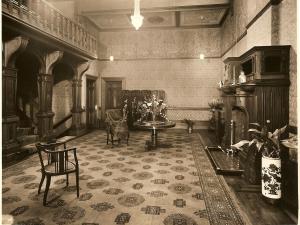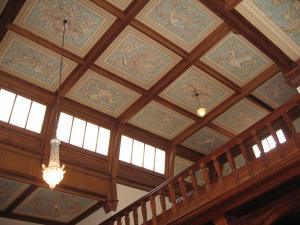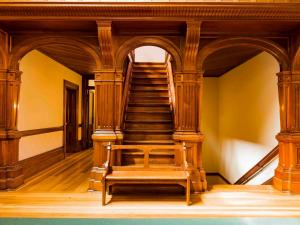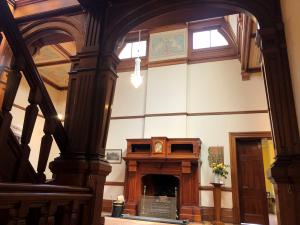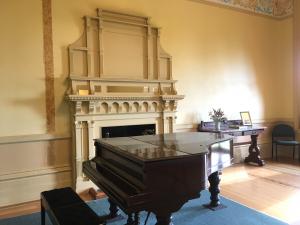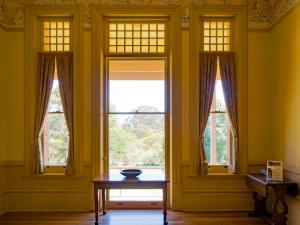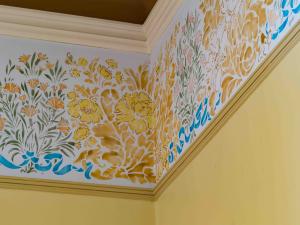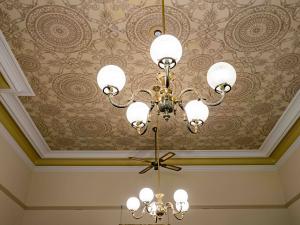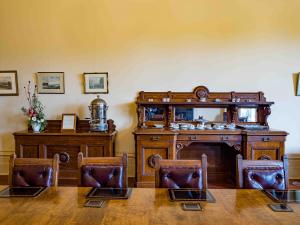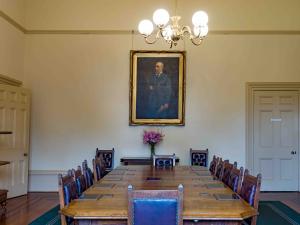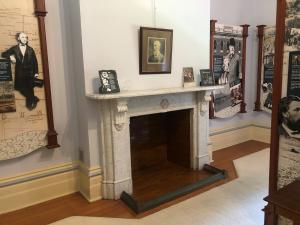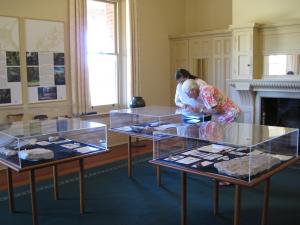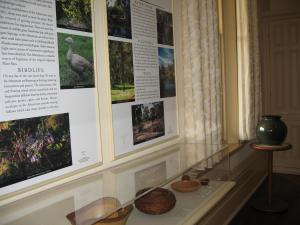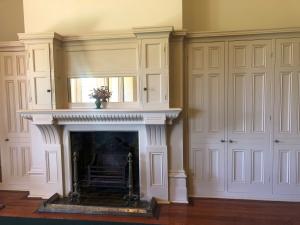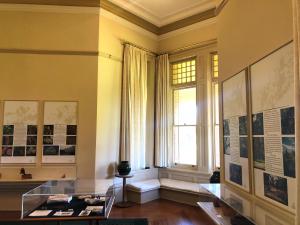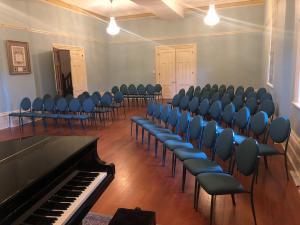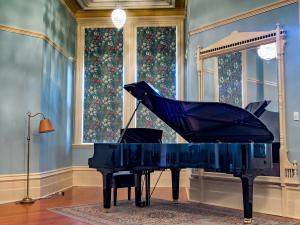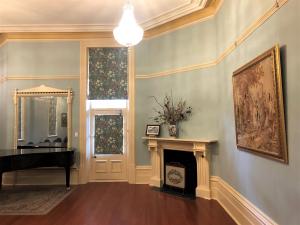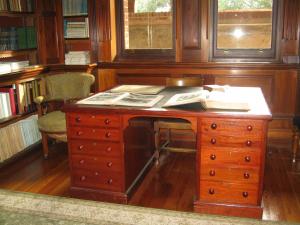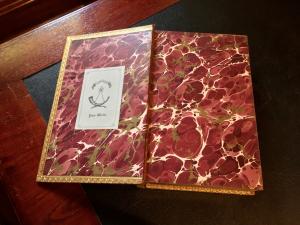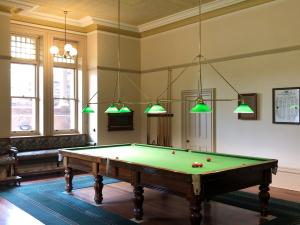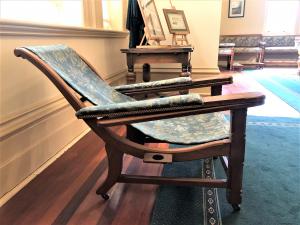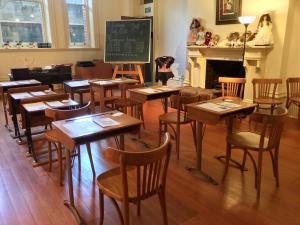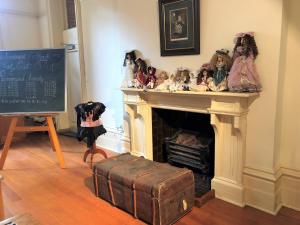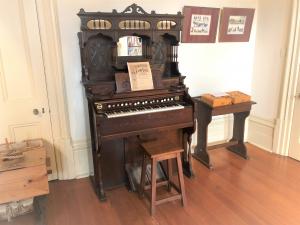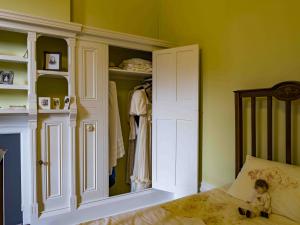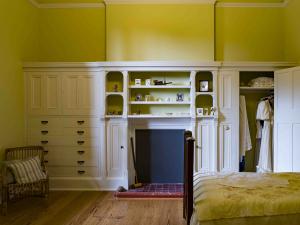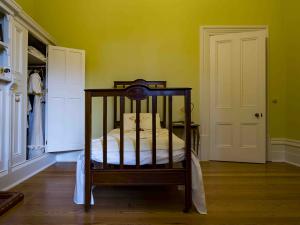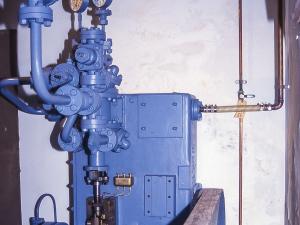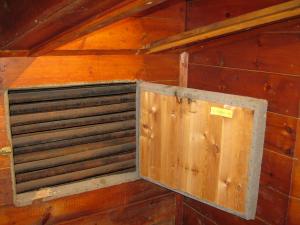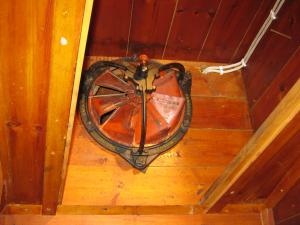The House
See inside the house via a few short videos with our historian and manager on our Youtube channel.
Upstairs rooms
-
Main Hall
The Main Hall was the formal reception area of Urrbrae House. The Hall features the original ceiling papers designed by English designer Aldam Heaton, and ornate woodwork in cedar and blackwood.
Musicians would and are still able for perform to guests from the impressive Minstrels' Gallery. This space was also used as a small picture gallery during the Waite era (1892-1922).
The fireplace and in-built clock are original features in the Hall, while the wooden bench seat belonged to the Waite family
-
Drawing Room
The Drawing Room was restored in 1992. Remnants of the original wall, ceiling and frieze papers discovered at that time, have been conserved. The entire wall paper frieze was recreated in the 1994 by Leonie Woolhouse.
The original fireplace tiling and mantelpiece, which was lost in the 1950s when the room was converted into two bedrooms and a bathroom, have been reconstructed. The fireplace has an original grate and brass firedogs.
The Drawing Room is the only room in Urrbrae House to have its original curtains from when the Waites lived in the House. The curtains were generously returned to Urrbrae House in recent years by Peter Morgan, great-grandson of Peter Waite. Their conservation was paid for by the Friends of Urrbrae House.
Another original feature in the room is a tapestry firescreen which was kindly restored to the House by Marion Wells, great-granddaughter of Peter Waite.
The Drawing Room also features an 1896 Steinway & Sons grand piano donated to the University of Adelaide for Urrbrae House by the eight grandchildren of Mrs Beatrice E Michell (1905 - 1992) who was the former owner of the piano.
The Drawing Room and grand piano are regularly used for concerts and events.
-
Dining Room
The Dining Room overlooks the picturesque rose gardens behind Urrbrae House.
The furniture in this room is original, having been made for the Waite family in Edinburgh, Scotland by John Taylor and Sons in 1876.
The sideboard features the family crest of a hunting horn and the family's motto: 'fac et spera' (do and hope).
Overlooking the oak dining table is a painting of Peter Waite by G. R. Webb commissioned by the University in 1923.
The black marble fireplace was saved from the first single-storey Urrbrae House which was demolished to make way for the current house.
-
Peter Waite Exhibition Room
The Peter Waite Exhibition Room was originally used by the Waite family as the Morning Room and affords a fine view to the front of Urrbrae House, towards the majestic 800 metre eucalypt-lined driveway.
The Peter Waite Exhibition room houses photographs and memorabilia associated with South Australian history and the Waite family. Included in this collection is a rare photograph of Matilda Waite in the Morning Room.
This permanent exhibition on the history and restoration of the House was opened in 1994.
-
Arboretum Exhibition Room
The Arboretum Exhibition Room, once the original Master Bedroom of Urrbrae House, has stunning views overlooking the Waite Arboretum and Twentieth Century Rose Garden.
The bedroom originally had a walk in dressing room and ensuite bathroom. The in-built wardrobes and fireplace are original features of the room.
This permanent display features items made from Arboretum timbers and included is a beautiful exhibition of fossilised leaves and fruits of the ancestral species of trees represented.
Informative panels bring to light some of the special collections in the Waite Arboretum.
Downstairs rooms
-
Ballroom
The Ballroom and adjacent lounge/supper room (now School Room) are on the lower level of Urrbrae House. These rooms were designed to receive natural light from abundant windows and have easy access to the lower verandah.
During Adelaide's hot summers, Peter Waite and his family often moved into the Ballroom to escape the worst of the heat. The large mirror and mantlepiece are the only remaining original features. In the 1970s and 1980s the room was used for a student cafeteria/refectory.
In 1996 the Ballroom was renovated and until 1999 housed the National Textile Museum of Australia.
From 2000 onwards the space has been used for events and concerts.
In 2014 generous benefactor, Margaret Neate, donated a Yamaha grand piano for the ballroom to enable a wider range of concerts to be held in the house. Since then the Ballroom has been redecorated to recapture some of its past grandeur. In 2016 the Friends of Urrbrae House funded the reinstatement of five crystal chandeliers in the room.
-
Library
The Library is located on the lower ground floor and contains books that once belonged to the Waite family and those collected during the early period of the Waite Institute.
The collection reflects Peter Waite's great interest in new technology, including new inventions such as refrigeration and electricity.
The shelving, with its leather dustcovers and original tub chairs in this room belonged to Peter Waite.
The desk is believed to be that of the first Director of the Waite Institute, Professor Arnold Richardson, who used the room as his office before the John Melrose Laboratory (now Main Waite Building) was opened in 1929.
-
Billiard Room
In Peter Waite's time, the Billiard Room was also known as the "Smoking Room", because it was the only room in the house where smoking was permitted. The room contains various pieces of original furniture and fittings. A small closet room, off the Billiard Room, was used by Eva Waite as a photographic darkroom.
The main focus of the Billiard Room is the magnificent Alcock & Co "Squatter's Favourite" billiard table. While the room was predominantly a male domain, during a visit in August 1895 artist Arthur Streeton wrote that he played billiards with Peter Waite and his daughters while he and Waite were "gushing about art the whole time".
By the 1990s after years of use (including by many students during 1970s and 1980s) the billiard table was in need of restoration. The billiard table was restored and the room's rug replaced in 1997.
Timber framed settees with footrests in the north bay and northeast corner of the room have been re-upholstered but retain their original woodwork. Two verandah or squatters chairs with their original tapestries from the Waite era are also found in the Billiard Room and downstairs hallway.
The lighting in the room is a replica of the original style of lighting used in the 1890s.
Much of the renovation of the Billiard Room and Library has been funded through the efforts of the Friends of Urrbrae House.
-
School Room
The Supper Room (now School Room) was used as a lounge room where guests could avail themselves of refreshments when a ball was being held.
The room is now a recreated late Victorian School Room which is used in education programs for school children.
An 1890s Varley sewing machine is on display.
On the walls are an 1897 chromolithograph of Queen Victoria and 1864 engravings of pictorial lessons used by governesses for children’s education.
The school desks range in age, with two cast iron desks dating back to the 1880s.
-
Eva's bedroom
Originally one of the younger Waite daughters’ bedrooms, recent restoration of the room reflects Eva’s bedroom as it might have looked in 1892 when Eva was 12 years’ old.
As part of the restoration the original built in wardrobes were reinstated and house photographs of Waite children Eva, James and Agnes, as well as Victorian era antiques: stereograph, Calsbad (Austria) dressing table set, greeting cards and postcards, and English (c.1900) silver hair brush and clothes brush.
The bed is an 1890s Sheridan revival child’s bed. Reproduction quilts on the bed and cot, and dolls dresses were made by Urrbrae House volunteer, Anne Rabone. Antique cotton nightdress and christening gowns are displayed on the bed and the cot (c.1900 donated by Kerin Williams).
-
Refridgeration plant
The refrigeration plant in the basement rooms of Urrbrae House was designed and installed by Wildridge & Sinclair of Sydney for Peter Waite in 1895. It was the first domestic refrigeration plant in Australia. The plant consists of four rooms:
- plant room containing the compressor, electric motor and other equipment
- freezer or chiller room and
- two coldrooms
The refrigeration plant was restored by a group of enthusiastic volunteers led by Ray White of White Refrigeration and the late Dr John Pickles. The restoration was completed in 1996 and is recognised with a Historic Engineering Marker plaque at the entrance to Urrbrae House.
Currently, the refrigeration plant is not open to the general public. Major salt damp treatment of the basement levels of Urrbrae House in recent years necessitated the dismantling and storage of the refrigeration plant equipment. Once moisture levels have stabilised, repair work to the walls of the plant rooms will be undertaken and the equipment will be reinstated.

